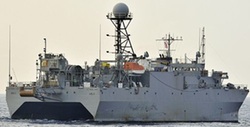In August, the National Marine Fisheries Service issued its Record of Decision that will allow the Navy to operate its Low Frequency Active Sonar systems for the next five years. NMFS will issue a new Letter of Authorization each year, in order to accommodate new information as needed, but the overall parameters of the permits will remain essentially the same throughout the five years.
 While the Final Rule allows the Navy to operate the SURTASS-LFA sonar in most of the world’s oceans (Pacific, Indian, Atlantic Oceans and Mediterranean Sea), the Navy’s operational plans for the first year remain centered in the western Pacific, given its particular focus on tracking Chinese submarines (see previous AEI coverage of tensions with China over LFAS surveillance). Only four missions are planned in other areas, and all these will take place in north and south of Hawaii. The Navy has four ships outfitted with the SUTASS-LFA sonar; three (USNS Victorious, Effective, and Able, seen at left, appear to be based in the Pacific, and one (USNS Impeccable) in the Atlantic; each ship could operate for up to 240 days and transmit SURTASS LFA sonar for up to 432 hours per year (the ships transmit sound roughly 7.5% of the time they are operating).
While the Final Rule allows the Navy to operate the SURTASS-LFA sonar in most of the world’s oceans (Pacific, Indian, Atlantic Oceans and Mediterranean Sea), the Navy’s operational plans for the first year remain centered in the western Pacific, given its particular focus on tracking Chinese submarines (see previous AEI coverage of tensions with China over LFAS surveillance). Only four missions are planned in other areas, and all these will take place in north and south of Hawaii. The Navy has four ships outfitted with the SUTASS-LFA sonar; three (USNS Victorious, Effective, and Able, seen at left, appear to be based in the Pacific, and one (USNS Impeccable) in the Atlantic; each ship could operate for up to 240 days and transmit SURTASS LFA sonar for up to 432 hours per year (the ships transmit sound roughly 7.5% of the time they are operating).
The Rule and the Letters of Authorization allow the Navy to cause temporary behavioral effects (a “Level B Harassment,” defined as animals hearing the low-frequency sonar at levels ranging from 120-180dB, possibly changing their behavior) on 94 species, with no more than 12% of any regional stock of each species being exposed to the sonar in any given year. The Navy anticipates, based on species abundance in each of the eleven designated operational areas for the first year, that for most species, the percentage will be far lower: usually well under 1% and topping out at 3% for a handful of species in the 9 western Pacific operational areas; around Hawaii, several species will see 1-3% of the population having behavioral impacts, with a handful of species topping out at 6-7%.
Few animals are expected to be close enough to be injured, and the Navy and NMFS presume that physical harm (Level A Takes) will be avoided completely thanks to various mitigation measures, including marine mammal observers, passive acoustic monitoring, and power-downs when whales are close. But given the uncertainties, NMFS is authorizing injurious or lethal takes of up to 31 whales and 25 seals and sea lions.
The previous five-year LFAS permits, issued in 2007, faced a court challenge based largely on the ways that the Navy and NMFS designated offshore biologically important areas (OBIA), and on the idea that nearshore exclusion zones should extend at times beyond the 12 nautical mile zone covered by those permits. Most designated and potential Marine Protected Areas (340 of 403) are already within 12 nautical miles of coasts, so are protected from high-intensity ensonification; a more thorough examination of the rest led to the inclusion of one additional OBIA in this round of permitting, with two more being monitored for possible inclusion as more research is done in them (many were omitted because the species of concern in those areas are high- and mid-frequency vocalizers, and LFAS sounds will have more of an effect on larger whales that hear lower frequencies). A total of 22 OBIAs are designated worldwide, some considered important year-round, and some seasonally. Sonar sounds must be below 180db within an area extending 1km beyond the boundaries of the OBIAs (thus aiming to keep sounds under 175dB within the OBIAs); likewise, the same 180dB maximum will apply at the boundary of the 12 nautical mile coastal zone. The Federal Register notice of the Final Rule contains many pages of comments from the NRDC, Marine Mammal Commission, and others, along with responses from NMFS.

 Brad Hanson and colleagues at NOAA’s Northwest Fisheries Science Center are currently conducting a second year of
Brad Hanson and colleagues at NOAA’s Northwest Fisheries Science Center are currently conducting a second year of  While the
While the